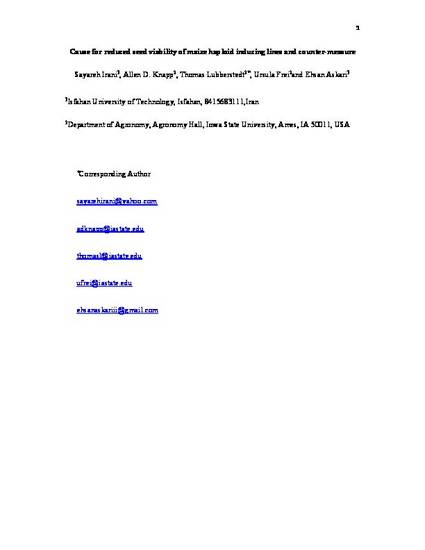
Some haploid inducing lines used in the production of maize doubled haploids (DHs), express germination problems and reduced vigor. In this study, haploid inducing lines RWS, RWK-76 and their reciprocal hybrids RWS/RWK-76 and RWK-76/RWS were examined for viability by Tetrazolium (TZ) and germination ability by standard germination tests. Evaluation based on TZ tests showed that 59% of the seed of RWK-76/RWS were not viable, compared with only 12% dead seed in RWS/RWK-76. Similarly, the percentage and speed of germination in RWK- 76/RWS (25%, 1.53) was lower than for RWS/RWK-76 (74%, 4.30). In an effort to develop a quick method for assessing seed viability in these lines, the TZ test was repeated in a different way. Seed from each genotype was placed in beakers containing distilled water.Seed would either float or sink. Subsequent TZ testing confirmed that seed that floated was dead, and seed that sank was alive, although some of them had defective embryos. The dead seed in both genotypes failed to develop an embryo, leaving an empty cavity that would fill with air and cause seed to float on water. This feature can be exploited for a simple and practical method to separate living from dead seed. In addition, we surveyed theig1 (indeterminate gametophyte) gene as a candidate for germination problems in inducer lines.Sequencing data from theig1 region showed that RWS and RWK-76 differed in one nucleotide and amino acidin the firstexon of ig1.Segregation of ig1 alleles from RWS and RWK-76 wassignificantly (P=0.01) distortedin the respectiveF2 population relative to the expected Mendelian segregation ratio (1:2:1). Thus, either ig1 or a linked gene in the ig1 region affect seed viability.
Available at: http://works.bepress.com/thomas-lubberstedt/61/

This is a manuscript of an article published as Irani, Sayareh, Allen D. Knapp, Thomas Lubberstedt, Ursula Frei, and Ehsan Askari. "Increasing Seed Viability of Maize Haploid Inducing Lines by Genetic and Non-Genetic Approaches." Crop Science 56, no. 4 (2016): 1940-1947. doi: 10.2135/cropsci2015.11.0713. Posted with permission.